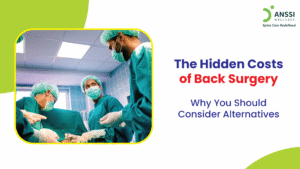A herniated disc, sometimes referred to as a ruptured or slipped disc, is a common spinal problem that can significantly impair your everyday functioning and cause severe pain. It occurs when the soft, gel-like inner portion of a spinal disc pushes through a tear in the disc’s tougher exterior.
This condition can affect any part of the spine but most frequently appears in two areas: the lower back (lumbar spine) and the neck (cervical spine). While both can lead to nerve compression and pain, the symptoms and impact on mobility vary significantly depending on the location of the herniation.
What is a Herniated Disc?
A herniated disc is the result of wear and tear or injury to the spinal disc, which acts as a cushion between vertebrae. As we age, these discs lose water content and become less flexible, making them more prone to rupturing with even minor strain or movement. Inappropriate lifting practices, poor posture, abrupt trauma, and repetitive stress are additional factors.
When the inner disc material bulges out, it can press against spinal nerves, leading to pain, inflammation, and nerve-related symptoms. The specific symptoms depend on where the disc herniation occurs in the spine.
Location and Symptoms: Cervical vs. Lumbar Herniated Discs
The primary difference between the two lies in the pattern of symptoms and which nerves are involved. A herniated disc in the cervical spine affects nerves that control the upper body, while one in the lumbar spine affects the lower extremities.
Understanding the differences between cervical and lumbar disc herniation is crucial in identifying the source of pain and choosing the right treatment path.
Cervical Herniated Disc (Neck)
This type of herniation affects the upper part of the spine. It often results in pain that originates in the neck and can radiate to the shoulders, arms, and even into the hands and fingers.
- Patients commonly report numbness, tingling, or a pins-and-needles sensation in the arms or hands.
- Muscle weakness in the upper limbs may also occur.
- Because the cervical spine connects to the upper body, herniated discs in this region can significantly impair arm and hand function.
Lumbar Herniated Disc (Lower Back)
The lumbar spine bears much of the body’s weight and is a common site for disc herniation.
- Symptoms often include lower back pain that radiates into the buttocks, thighs, and legs, causing a condition known as sciatica. People may experience burning, tingling, or numbness down one leg, as well as weakness in the foot or difficulty lifting it (foot drop).
- Since the lumbar region affects the lower body, mobility and walking can be affected in more severe cases.
Diagnosis and Non-Surgical Treatment Options
If you are experiencing persistent neck or back pain with symptoms like tingling or weakness, it’s important to seek medical attention. A spine specialist may conduct a physical examination and recommend imaging tests such as X-rays, MRI, or CT scans to confirm the diagnosis and locate the herniated disc.
Once diagnosed, most herniated disc cases can be managed without surgery. Conservative treatment focuses on relieving pain, reducing inflammation, and restoring function.
Physiotherapy
Targeted exercises and manual therapy help relieve pressure on the affected nerve, improve flexibility, and strengthen supporting muscles. A physiotherapist can guide you through specific neck or back exercises tailored to the site of the herniation.
Non-Surgical Spinal Decompression Treatment
This advanced treatment option gently stretches the spine, relieving pressure on the spinal discs and allowing bulging material to retract. Clinics like ANSSI Wellness specialise in non-surgical spinal decompression using USA technology-based protocols, providing relief from cervical and lumbar disc herniation without medications or surgery.
Pain Management
Medications such as anti-inflammatory drugs or muscle relaxants may be used to manage acute symptoms. However, long-term dependency on medication is not recommended.
Posture Correction and Ergonomic Changes
Adopting correct posture while sitting, standing, and working can prevent the worsening of symptoms. Using ergonomic chairs, standing desks, and supportive cushions can significantly reduce daily spinal stress.
Lifestyle Modifications
Staying active, maintaining a healthy weight, avoiding prolonged sitting, and engaging in regular low-impact exercise like walking or swimming, can support spinal health and prevent future episodes.
When is Surgery Needed?
Surgery is usually considered only when non-surgical treatments fail to improve symptoms over several weeks or months, or if there is significant nerve damage, loss of bladder/bowel control, or severe weakness. Surgical options may involve removing part of the disc or spinal fusion in advanced cases.
About ANSSI:
ANSSI Wellness focuses on improving the quality of life for patients suffering from spinal issues, aiming to provide relief where other conventional treatments have failed. Through advanced non-surgical spinal decompression treatment, ANSSI is committed to helping patients avoid surgery and recover in a safe, effective, and compassionate environment.
Connect with ANSSI Wellness on LinkedIn, Instagram, and Facebook for expert guidance.



